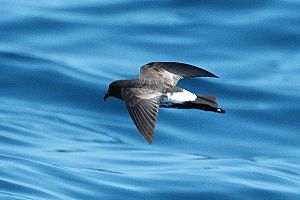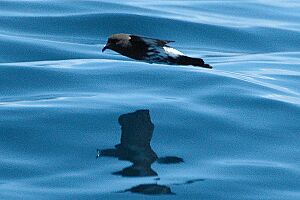New Zealand storm petrel facts for kids
The New Zealand storm petrel (Fregetta maoriana) is a small seabird that lives in the ocean. For a long time, people thought this bird was gone forever, as it hadn't been seen since 1850. But since 2003, people have started seeing them again! This means there's a hidden group of these special birds still alive.
As of 2010, the New Zealand storm petrel is listed as critically endangered. This means there are very few of them left, and they are at a very high risk of disappearing completely. Scientists believe there are fewer than 2,000 New Zealand storm petrels in the world.
Quick facts for kids New Zealand storm petrel |
|
|---|---|
 |
|
| Conservation status | |
| Scientific classification | |
| Genus: |
Fregetta
|
| Species: |
maoriana
|
| Synonyms | |
|
Oceanites maorianus |
|
Contents
What Does the New Zealand Storm Petrel Look Like?
The New Zealand storm petrel is a small seabird. Its top parts are dark brown or black, but it has a white patch on its back, near its tail. Its throat and chest are black, but its belly is white with some black stripes. When it flies, its feet stick out past its tail.
This storm petrel is active only at night when it's at its breeding sites. This helps it avoid bigger, more aggressive birds like gulls and skuas that might try to hunt it. Like most petrels, it doesn't walk very well. It can only shuffle a short distance to its burrow, which is its home.
This bird is different from another common petrel in New Zealand, called Wilson's storm-petrel. The New Zealand storm petrel has a light bar on its upper wing, a white belly with stripes, and narrow white areas under its wings. It also has longer legs and dark webbing on its feet. When it's not breeding, it stays out at sea in the open ocean. Because it lives far out at sea and breeds in secret places, it's a very hard bird to spot!
How Scientists Classified This Bird
Sometimes, people thought the New Zealand storm petrel was just a type of Wilson's storm petrel. But it is actually quite different. In 2011, scientists took DNA samples from old museum specimens of the bird in England and France. They found that this DNA matched the DNA of the birds seen in the Hauraki Gulf in New Zealand.
The study also showed that this bird is probably more closely related to storm petrels in the group called Fregetta than to those in the group Oceanites.
The Amazing Rediscovery
For many years, everyone thought the New Zealand storm petrel was extinct, meaning it no longer existed. But on January 25, 2003, something amazing happened! Sav Saville, Brent Stephenson, and others thought they saw one near the Mercury Islands, off the Coromandel Peninsula of New Zealand's North Island. They took some photos, but they weren't clear enough to be sure.
Then, on November 17, 2003, while looking for other types of storm petrels, Bob Flood and Bryan Thomas got clear photos and videos of 10 to 20 New Zealand storm petrels! This happened off Great Barrier and Little Barrier Islands in the Hauraki Gulf.
Later, in late 2005 and early 2006, four storm petrels were caught and then released in the same area. Three of them had small radio transmitters attached. Since then, tour operators have regularly seen these birds in the Hauraki Gulf.
Finding Their Breeding Place
At first, the tagged birds could only be tracked when they were out at sea. Scientists tried hard to find where the birds were breeding, but they couldn't. Finally, in 2013, a breeding site was discovered on Little Barrier Island!
A team of researchers from Auckland University, led by Chris Gaskin and Matt Rayner, found the breeding site in the Hauraki Gulf Marine Park in February 2013. The researchers are being very careful not to disturb the birds. They are watching them from a distance. They hope to learn how many New Zealand storm petrels are left and where else they might live.
In February 2014, an egg of the New Zealand storm petrel was found for the first time on Little Barrier Island. It was about 31 millimeters long and 23 millimeters wide. It was white with tiny pink spots, mostly at one end.
See also
 In Spanish: Paíño de Nueva Zelanda para niños
In Spanish: Paíño de Nueva Zelanda para niños



